- Home
- Our Work
- Types of Assistance
- Technical Cooperation
- Distance Technical Cooperation - JICA-Net
- JICA-Net multimedia-based learning materials Sample Activities
- JICA Tohoku; The village, which had heavy snow, poverty, and was prone to sickness, turned into a longevity village -Learning the efforts for UHC from the experience of Sawauchi village in Iwate Prefecture, "Community Development that leaves no one behind -Health services for future generations-"
JICA Tohoku
The village, which had heavy snow, poverty, and was prone to sickness, turned into a longevity village -Learning the efforts for UHC from the experience of Sawauchi village in Iwate Prefecture, "Community Development that leaves no one behind -Health services for future generations-"
A new material is released to learn rural development history in modern Japan.
From Meiji Restoration, Japan promoted modernization in its own original style while learning from western countries and became the first non-western developed country. This process is regarded as one of the best models for developing countries to aim for development. The history of development in the modern period remains in various places of Tohoku region. JICA produces video materials to convey JICA International students and participants these marks of rural development because learning the perspective of community development is very valuable for those who are expected to play a role in the development of their own countries.
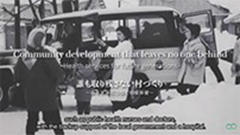 A new released material, "Community Development that leaves no one behind -Health services for future generations-"
A new released material, "Community Development that leaves no one behind -Health services for future generations-"
The JICA-Net multimedia-based learning material we newly produced at this time is "Community Development that leaves no one behind -Health services for future generations-" (YouTube, external link).)
The topic of the material is Sawauchi village (Currently Nishiwada town) in Iwate Prefecture, which is known as the village where advanced comprehensive community healthcare was achieved in the 1960s. The material includes various knowledge as a learning material for JICA's training program in the field of maternal and child health and also as a historical material that keeps the legacy of the region.
Sawauchi village's monumental work has been already taken up in many documentaries, TV programs, and learning materials.
The material includes many recent interviews with doctors and public health nurses who were involved in the monumental work directly, which were recorded during the 3 years of the COVID-19 pandemic that people around the world were facing.
We visualize together what we consider Sawauchi village's efforts and success factors from the present point of view where SDGs and UHC have already penetrated into society, and how the experiences and the feelings of the past are connected to the current social development of Nishiwada town.
*UHC (Universal Health Coverage)
All people have access to the full range of quality health services they need, when and where they need them, at affordable costs.
Various proposals for community development not limited to the medical field
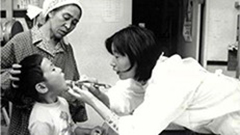 The healthcare activities in Sawauchi village in those days
The healthcare activities in Sawauchi village in those days
Sawauchi village's advanced effort has become a subject that domestic and international healthcare professionals have learned. It covers not only comprehensive community healthcare but also other fields such as maternal and child health, welfare, and public healthcare widely. Furthermore, the knowledge from the efforts is above the medical and healthcare field. The attitude of villagers improving their lives together indicates what is important in community development.
Sawauchi's reform was achieved by not only the local government and health professionals but also villagers' respective efforts and a symbiotic culture of helping each other against a harsh environment.
Particularly noteworthy is the point of practicing various unconventional ways. Even now, when they face issues such as decreasing birthrate, aging population, depopulation and infections, Nishiwaga Town's local autonomy continues.
For many years, JICA staff involved in international cooperation have got a lot of the knowledge from Sawauchi village. And JICA participants' countries have many issues to be solved. Through the material, we hope that many people will learn how Sawauchi village advanced "Community Development that leaves no one behind" and kept lives for the future.
The bond between Sawauchi village and Nishiwaga town, and JICA
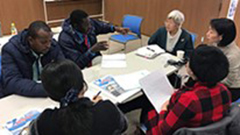
JICA has been performing various sort of training programs in cooperation with Sawauchi village for many years and the knowledge we got there has been used to improve developing countries. One of the ex-public health nurses interviewed when we produced the material was involved in the acceptance of JICA participants in the village, and another visited Mexico and Thailand as a follow-up for training.
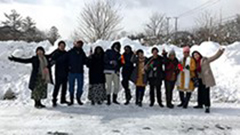 Visiting Nishiwaga town in "Continuum of Care (CoC) for Maternal, Newborn and Child Health (MNCH) and UHC" in the past
Visiting Nishiwaga town in "Continuum of Care (CoC) for Maternal, Newborn and Child Health (MNCH) and UHC" in the past
Those connection has continued until now, and in JICA Knowledge Co-Creation Programs, "Continuum of Care (CoC) for Maternal, Newborn and Child Health (MNCH) and UHC", we have visited Nishiwaga town as a part of the training. Although this visit is suspended now because of COVID-19, in FY2022 follow-up session for the training, the material played a role in delivering the knowledge of Sawauchi village.
A related page
- Follow-up session of "Continuum of Care (CoC) for Maternal, Newborn and Child Health (MNCH) and UHC"
To keep valuable experiences of the community for future generations
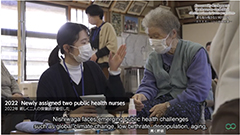 The spirit of Sawauchi village is passed to the health activities of Nishiwaga town in the past
The spirit of Sawauchi village is passed to the health activities of Nishiwaga town in the past
We would like this material will be widely viewed by health professionals who are involved in maternal child health and UHC and international students who study in universities in the Tohoku area as well as participants of JICA Knowledge Co-Creation Program.
We also discuss utilizing the material as an education for children who will bear the next generation and as an inheritance of Sawauchi village's experience in Nishiwaga town and Iwate Prefecture.
When we visited Nishiwaga town for a meeting on video production, we received comments from ex-public health nurses and doctors, for example, "The fact that many people from domestic and international visited Sawauchi village let us know that our experiences are valuable. People who were engaged in health activities in those days are aging, so it is very thankful that the community history was kept through the material to convey juniors and children important things."
JICA will expand the use opportunity of the material, hoping that it will bring more knowledge and become a valuable material for community people.
ISAWA Hitomi
JICA Tohoku
*The Material(s) mainly applied
Community Development that leaves no one behind -Health services for future generations-
Sawauchi village in Iwate Prefecture had the highest infant mortality rate in Japan. Heavy snow, poverty, and public health issues were problems there.
Yet, the village, which was once described as a snow-cage-like place, achieved the zero infant mortality rate in 1962. The question is how.
This video introduces what it means to be human by showing the efforts to achieve the zero infant mortality rate and how this achievement changed people's sense of fulfillment.
- [JNL] Community Development that leaves no one behind -Health services for future generations-(Full) (YouTube, external link) Japanese ver. with English subtitles
- [JNL] Community Development that leaves no one behind -Health services for future generations-(Digest) (YouTube, external link) English digest ver.
- [JICA-Netライブラリ] 誰も取り残さない村づくり〜命を未来につなぐ地域保健〜 (ダイジェストver.) (YouTube, external link) Japanese digest ver.

- Thematic Issues
- Types of Assistance
- Partnerships with Other Development Partners
- Climate Change / Environmental and Social Considerations
- Evaluations
- Compliance and
Anti-corruption - Science and Technology
Cooperation on Global
Issues - Research
- JICA Development Studies
Program / JICA Chair - Support for the Acceptance of Foreign HRs / Multicultural and Inclusive Community
- About JICA
- News & Features
- Countries & Regions
- Our Work
- Thematic Issues
- Types of Assistance
- Partnerships with Other Development Partners
- Climate Change / Environmental and Social Considerations
- Evaluations
- Compliance and Anti-corruption
- Science and Technology Cooperation on Global Issues
- Research
- JICA Development Studies Program / JICA Chair
- Support for the Acceptance of Foreign HRs / Multicultural and Inclusive Community
- Publications
- Investor Relations
